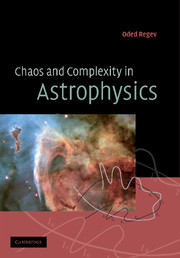Book contents
- Frontmatter
- Contents
- Preface
- Acknowledgements
- Part I Dynamical systems – general
- Part II Astrophysical applications
- 8 Introduction to Part II
- 9 Planetary, stellar and galactic dynamics
- 10 Irregularly variable astronomical point sources
- 11 Complex spatial patterns in astrophysics
- 12 Topics in astrophysical fluid dynamics
- References
- Index
10 - Irregularly variable astronomical point sources
Published online by Cambridge University Press: 14 January 2010
- Frontmatter
- Contents
- Preface
- Acknowledgements
- Part I Dynamical systems – general
- Part II Astrophysical applications
- 8 Introduction to Part II
- 9 Planetary, stellar and galactic dynamics
- 10 Irregularly variable astronomical point sources
- 11 Complex spatial patterns in astrophysics
- 12 Topics in astrophysical fluid dynamics
- References
- Index
Summary
Our whole knowledge of the world hangs on this very slender thread: the re-gu-la-ri-ty of our experiences.
Luigi Pirandello, The Pleasure of Honesty.The classical astronomical sources of radiation, stars and star-like objects, are spatially unresolvable. This fact does not exclude, however, the possibility of timevariability, and indeed a variety of point sources have been found to possess such intrinsic variability, that is, one that remains in the light curve after atmospheric and other local effects are properly eliminated. Different classes of objects exhibit a wide range of variability timescales, often depending also on the spectral range.
When an astronomical source emits a time-variable signal, the natural first step in the data analysis is to search for periodicity. The identification of well-defined periods provides extremely valuable information, which can be used in understanding the relevant physical processes and therefore in constructing viable physical models of the astronomical source. This is obvious if we consider as an example the simplest periodic physical system of them all, the harmonic oscillator. Its period immediately reveals the ratio of the inertia to the restoring force and since every sufficiently small oscillation is to a good approximation harmonic (i.e., linear), the number of physical systems modelled with the help of this paradigm and its generalisations (multidimensional linear systems) has been very large. In astronomy the most prominent examples of this kind are pulsating stars. The famous period–luminosity relations of the classical Cepheids and other pulsating variables have not only been instrumental in the development of stellar pulsation theory, they have also played an important role in establishing the cosmic distance scale.
- Type
- Chapter
- Information
- Chaos and Complexity in Astrophysics , pp. 317 - 346Publisher: Cambridge University PressPrint publication year: 2006



